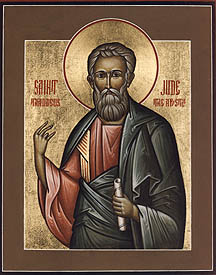Introduction
Authorship
 The author of the epistle simply identifies himself as “Jude, a servant of Jesus Christ and brother of James”. The word used here is “Ioudas” (Ἰούδας) and is the Greek form of the Hebrew name “Judah”. Unfortunately, there are quite a few people in the New Testament with the name “Jude”/“Judas”:
The author of the epistle simply identifies himself as “Jude, a servant of Jesus Christ and brother of James”. The word used here is “Ioudas” (Ἰούδας) and is the Greek form of the Hebrew name “Judah”. Unfortunately, there are quite a few people in the New Testament with the name “Jude”/“Judas”:
1. The Betrayer (& Apostle)
Judas Iscariot (Mark 10:4). Since he killed himself during the Passion, it can’t be this man.
2. The Apostle
Jude Thaddaeus (Luke 6:16, Mark 3:18). Some scholars suggest that he is the author of this letter.
3. The Christian Prophet
In Acts of the Apostles we encounter a prophet named “Judas called Barsabbas” (Acts 15:22) sent by the Council of Jerusalem back to Antioch. Some scholars suggest that he is the man behind this letter.
4. Kinsman of Jesus
One of the four men identified in the New Testament as a “kinsman” of Jesus is called “Judas” (Matthew 13:55; Mark 6:3). The majority of scholars think that this is the author of the letter. They do this for two main reasons:
(a) He’s the only “Judas” that we know of with a brother named “James”.
(b) It explains why the author doesn’t identify himself any further, since his brother James was the well-known leader of the Jerusalem Church after Peter’s departure.
In opposition to this identification, some have said that the text of Jude is too well-written to have been written by a blue collar worker from Galilee. However, it should be noted that:
(a) First Century Galilee was almost certainly thoroughly bilingual, with tradesmen speaking both Aramaic and Koine Greek.
(b) We don’t know about the particulars of Jude’s education or aptitude for language.
(c) This letter may well have been written with the help of a scribe.
Date
Not only is the authorship of the letter unclear, there’s not any easily dateable historical information within the letter. As a result, scholars suggest authorship dates ranging from 50s to the early Second Century. There are four pieces of information which are significant in dating this document:
(a) Literary Dependence
There’s a close relationship in content between this letter and 2 Peter. Most scholars conclude that 2 Peter drew material from Jude. If we assign a probable authorship date of 2 Peter to the early to mid-60s, Jude must have been written no later.
(b) Indications of the end of the apostolic age
There are statements in the letter which could be understood to suggest that the apostolic age has either ended or is drawing to a close. If that is the case, it would push the date of composition later. However, these verses don’t necessarily have to be interpreted in this manner.
(c) Identifying the opponents
If the opponents described in the letter are Jews or Judaizing Christians, then the letter would be given an earlier date, when that was the main controversy in the Church. However, if the enemies mentioned in the letter are Gnostics, it would push the date later since this gnosticism didn’t arise until later in Church history.
(d) Jewish themes
The contents of the epistle assumes good knowledge of both the Old Testament and extra-canonical Jewish writings (1 Enoch and The Assumption of Moses). This suggests that the recipients of this letter were primarily of Jewish extraction, thus indicating an earlier period of the Church’s history when the Church was still predominantly populated by Jews.
For the purpose of this guide, we will assume that the epistle was authored sometime in the 50s and 60s.
Destination
The recipients of this epistle are not explicitly identified. The text does seem to suggest that the community to which Jude writes was one which was originally founded by apostles. This, coupled with the strong Jewish flavour of the letter and references to apocryphal Jewish literature, allows us to hypothesize that Jude was probably writing to a community in Palestine.
Themes
What we can gather from the text is that the community to which he writes is facing false teachers. Jude warns his readers against them and exhorts them to hold fast to their faith by deepening their understanding and wait patiently for the Lord.
To drive his point home, Jude draws on a examples from a number of different sources:
(a) Old Testament
(b) Old Testament Apocryphal Documents
Jude argues by typology using the Old Testament and apocryphal texts, showing how the wicked will always ultimately face judgement. He uses the Apostolic Teaching to argue by prophecy to foretell the end of these false teachers.